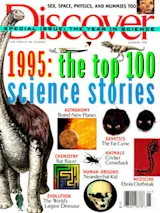This past year suffered from sky depression: Venus was a washout. Not one eclipse occurred over the United States. The best meteor show of the summer was ruined by a full moon. The sun reached its minimum sunspot level, almost guaranteeing there’d be no major eruptions of northern lights. Saturn’s rings turned edgewise and vanished. It was the year of the rat. As if to overcompensate, 1996 promises to inspire awe.
Not one but two total lunar eclipses occur over the mainland United States, a surfeit we’ll be treated to just twice more in the next 40 years. The first, on April 4, is just for people in the eastern half of the United States and Canada, who have the photographer’s dream of a weirdly distorted moon that rises already eclipsed. Then on September 27 the second shadowed moon floats over the entire continent. In a timely choreography between heaven and Earth, last September’s volcanic eruption in New Zealand threw copious dust into the stratosphere, which may alter Earth’s shadow so that either or both eclipses look lopsided or discolored.
No bright comet appeared in 1995, but prospects for a really exciting one, Comet Hale-Bopp, suddenly seem excellent. That unusually large intruder draws closer to Earth during 1996, brightening until it should become visible through binoculars; its expected naked-eye rendezvous is set for spring ’97. Meteors, too, will erupt in ideal conditions. During most years, one of the major showers--they occur in mid-August and mid- December--is washed out by a bright moon. This year, for the last time until 2004, both will share the sky with nothing more damaging than a harmless low crescent. The warmest months will also feature Jupiter, midnight’s brightest star. The planet-king is most luminous and closest on the very night when the greatest number of Americans are gazing skyward anyway: the Fourth of July!
Saturn, its rings safely reinstated and inclined at an interesting skinny angle, continues its 15-year upward trek. This proud owner of 20 moons will be well placed for observation between August and December; it will be brightest (and biggest through telescopes) in October.
In 1996, Venus offers its best apparition in eight years, along with a truckload of snappy close encounters with other celestial bodies. For nature buffs with little inclination to stir from an easy chair by a window, the sky in 1996 divides itself into two slices. If your clearest view faces west, then the first part of the year presents the best sights, as the fading fires of dusk form the backdrop for Mercury in April and for the brilliance of Venus from now through May.
But if you have an unobstructed east window, then after late spring switch your sky gazing to the hours before sunrise (4 to 5 A.M.). The predawn sky becomes the forum for close encounters between Saturn and the moon (on May 13 and again on July 7), between Venus and Mars (August 31), and between Venus and the blue star Regulus (a don’t-miss, on October 4, when as a bonus Mercury makes its best morning appearance). That busy east window also offers a Mars-Regulus meeting on October 30 and a moon- Venus rendezvous on December 8.
We will look at many other events as the months unfold. If times become trying below, the heavens have prepared an unusually rich banquet for anyone who raises his or her eyes in curiosity--or desperation.














